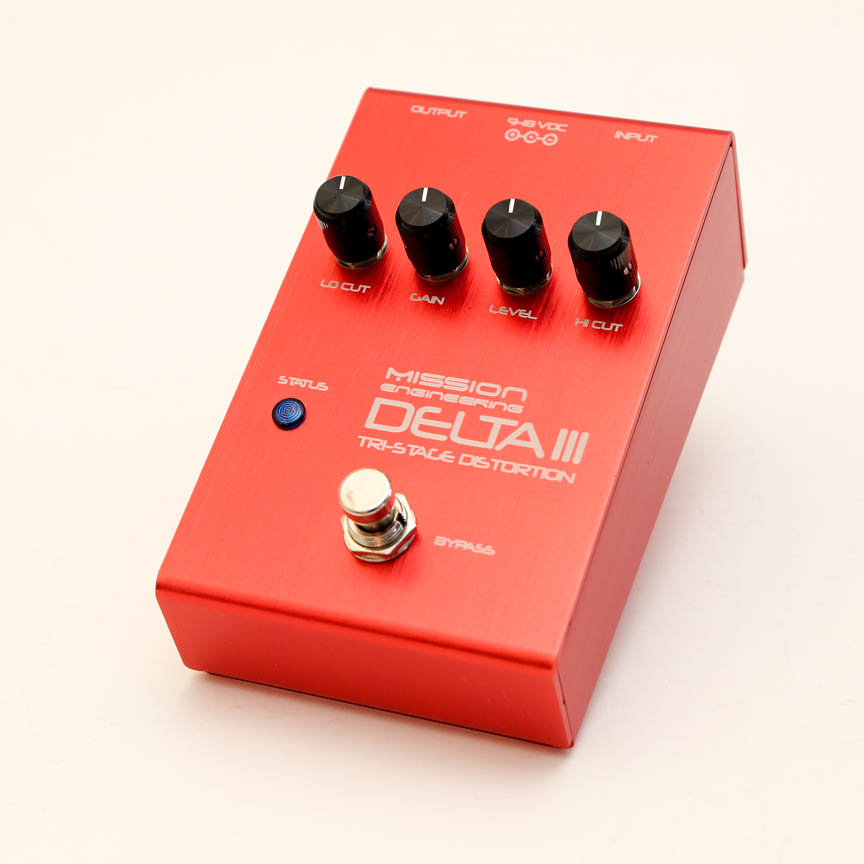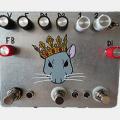 The fine folks at Mission Engineering sent over a Mission Engineering Delta III Distortion pedal for me to check out. I was already a big fan of Mission Engineering – I highly recommend their volume pedals (I currently own one.. and absolutely love mine).
The fine folks at Mission Engineering sent over a Mission Engineering Delta III Distortion pedal for me to check out. I was already a big fan of Mission Engineering – I highly recommend their volume pedals (I currently own one.. and absolutely love mine).
I was excited and surprised the they were entering the world of dirt boxes. As you guys know, there are a ton out there, and it’s tough to compete in this area of effects pedals… so the deck was stacked. I have to say, this pedal was full of surprises for me.
I’m currently playing through a Matchless HC-30 head into an Avatar 2×12 cabinet (close back) with a pair of Celestion Vintage 30 speakers. I tried out this pedal with a Fender ’62 AVRI Jazzmaster and a Travis Bean TB1000S. The Matchless generally handles pedals well and wanted to see how this amp reacted at different levels (on the pedal as well as with the amp).
One thing that jumped out immediately, was the control. I was honestly shocked by this, and amazed. Normally, with dirt pedals at high gain, my rig turns into a squealing demon, which is fine, but at all extreme settings with the Delta III, the harmonics held in place and everything was extreme, but incredibly easy to control. I don’t think I had this level of control on any distortion pedal with this set up before. Quite cool.
The next pleasant surprise was the footswitch. This is using a digital switching system.. so no pops on the true bypass. Normally, I’ve had issues with the soft touch switches in the past… but all the gripes I had with those (usually bouncing under foot) did not happen here. The switch was smooth as silk, silent and worked perfectly.
The Mission Engineering Delta III is described as a tri-stage distortion. This is based on the three transistors with analog circuit to achieve tones from classic Tube screamer to super fat fuzz.
The controls include Lo Cut, Gain, Level and Hi Cut. When I’ve seen ‘cuts’ before it was opposite of what you think, turning clock wise.. means cutting, counter clock wise was adding, but these controls are bit more intuitive. Turning clockwise added the lo or the high. Gain and level are pretty much self explanatory. I was happy with the ease of dialing in a nice mid range was there.
The manual provides some simple settings to get started with – Screamer, Mid Boost, Fat Fuzz and Fuzz. The variety of tones you got from simple adjustments were impressive. The screamer was typical Tubescreamer with more tonal control. I definitely preferred the Mid Boost and Fuzz settings the most. The pedal worked fantastic with the Jazzmaster and sounded super meaty with the humbuckers in the Travis Bean.
The Hi/Low cuts were impressive, but I have to say, the overall EQ was spot on. Meaning, the low never got too low, and the highs never achieved “ear knife”, the full range of EQ was extremely useable. I honestly think this is where they dialed things in ‘right’ that allows you great control. To dial in they ‘style’ of distortion, focus on the gain knob. Cranked.. that’s fuzz, dialed way back, that’s boost and middle or so.. that’s screamer.
Finally, the circuit is completed with an output buffer. I’m a big fan of quality buffers in the signal chain! the enclosure is an anodized aluminum enclosure with top mounted jacks.
If I have a chance.. I like to ask some questions to the builder. So I sent a follow up email to Paul Shedden, the designer of the Delta III circuit and asked for some insight on the pedal – what he was going for, what he was trying to avoid, etc. This is what Paul had to say:
Sure. The starting point was we have been working closely with a well known pick-ups manufacturer for a few years now looking at developing a Fuzz to work with their ‘active’ range, and I was keen to release something into this market re Mission. The distortion effect is a huge market to go at, but already highly populated with other great manufacturers. So it had to be more, simply more. Innovation is a big part of everything James (business partner and CEO) and I invent. The Delta III was my baby and the first question I asked myself was ‘overdrive’ or ‘fuzz’? Because of my childhood upbringing, I don’t like either or scenarios, so decided why not both. Now that I had the distortion concept sorted out it was just a question of what other popular effects would work along side distortion? The two most likely after compiling a list were boost (because this can cause distortion in it’s own right at extremes) and EQ, because the particular guitar frequencies processed by a distortion pedal very much affect the resulting sound. We already had success with variable boost via the electronics James came up with for our VBoost (variable boost) pedal and EQ is pretty simple to get right. I wanted all the features to work totally independent of each other, so that from a value for money point of view, it could be considered three separate pedals. But at the same time I wanted to be able to combine any of them to get very customizable sounds. I’m pretty happy I achieved this and am confident in saying this is the only distortion pedal a guitarist will ever need (and want hopefully). The way the EQ, Boost and Distortion interact with each other, means you can really dial in just what you are looking for and create your own sound or simply use them individually- and save a lot of real estate on your pedal board verses three separate pedals
I have to say, the Mission Engineering Delta III Distortion is a top-shelf distortion. Highly versatile in distortion character, control and in the tone range. It’s built with a lot of thought and it shows. You can pick up the Mission Engineering Delta III Distortion directly from Mission Engineering for $199.00. It’s worth every penny.
Definitely give a Mission Engineering a look. Check them out at their website, Facebook and Twitter!




Leave a Reply